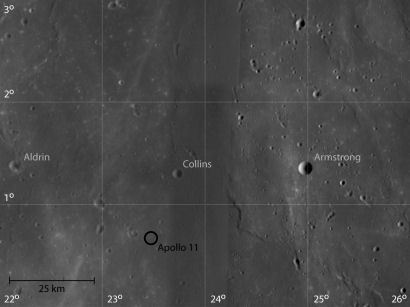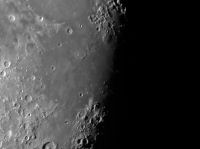A new view of the Apollo 11 landing site from SMART-1
20 July 2009
History was made at 03:56 CEST on 21 July 1969, when Neil Armstrong stepped off the lunar module and placed his left foot on the surface of the Moon. During this International Year of Astronomy the world celebrates the 40th anniversary of this inspirational event. The landing site of the Apollo 11 mission is just one of the many images of our closest neighbour taken by the SMART-1 spacecraft as it orbited the Moon between 2004 and 2006. |
This lunar map is a mosaic of images taken by the Advanced Moon Imaging Experiment (AMIE) on board ESA's SMART-1 spacecraft. The image shows the landing site of Apollo 11 and three prominent craters in the vicinity which have been named in honour of the astronauts on board the first mission to land humans on the Moon. The map combines images taken by SMART-1 during 7 orbits between 2004 and 2006. Click on the image above to find out more about them and to download the map.
The Moon for All Mankind
An image from SMART-1 was one of 40 contributions to "The Moon For All Mankind": an IYA project, organised by the IYA committee in Malta, celebrating of the 50th anniversary of the first unmanned lunar landing as well as the 40th anniversary of the first manned landing. This project constructed a very special and unique picture of the Moon from images that were submitted from 40 countries covering all five continents. Many pictures were taken by ground-based telescopes and during the full Moon in May and June 2009, however others are far older, such as Italy's entry; a four hundred year old sketch by Galileo Galilei. Images taken by the spacecraft that have pictured the Moon from orbit, including ESA’s SMART-1, are also included in the collage.
"The Moon for All Mankind" image used for Sea of Tranquility. Image courtesy of Mark Sibole, Mark's Tin Shed Observatory, Michigan, United States.

Significance of Apollo landing sites for future lunar missions
Apollo 11 was the first of six missions to land humans on the surface of the Moon; the last, Apollo 17, took place in 1972. Since then scores of spacecraft, developed by countries all around the world, have studied our closest celestial neighbour from orbit and via robotic landers.
During the manned Apollo missions, astronauts collected and returned nearly 400 kilograms of moon rock to Earth. These samples of the lunar soil have been thoroughly studied and are well understood, forming the backbone of almost all current Solar System science. The various Apollo landing sites provide areas of the lunar surface from which instruments, on board spacecraft studying the moon from orbit, can be calibrated and analytical techniques tested.
What is there still to learn about the Moon?
Although 40 years have passed since the first person stepped onto the lunar surface, much of what is known about the Moon today comes from the Apollo missions, and many questions still remain unanswered.
Studying the Moon plays an important role in understanding the formation and evolution of the Solar System, although currently little is known about the formation and structure of the interior of the Moon itself.
The cratered, ancient lunar surface provides a record of the history of the inner Solar System. Permanently cold craters may preserve chemicals from the early Solar System brought to the Moon perhaps by cometary impacts. The information from samples returned by the Apollo missions came from isolated areas of the Moon, in sites that contain a specific chemical structure which has since been found to be atypical of the Moon as a whole. Continued study of the lunar surface away from the Apollo landing sites is necessary to provide a complete picture of the Moon's chemistry and may even help to further understanding of the emergence of life here on Earth.
The Moon is our closet neighbour and therefore a prime candidate as a stepping-stone for humans to explore the rest of the Solar System. A lunar base would help humankind to learn how to live and work away from Earth before travelling further afield.
SMART-1
Launched in 2003, SMART-1 – a Small Mission for Advanced Research in Technology – was used to test solar electric propulsion and other deep-space technologies, while also performing scientific observations of the Moon. The mission ended on 3 September 2006 when the spacecraft, in a planned manoeuvre, impacted the lunar surface in the Lacus Excellentiae region.

